6 Min Read
The Secret of Great Humidity Control Part 2: Solving the Problem
Our previous blog post examined some of the problems of humidity control in custom homes. In this post, we discuss solutions; but if you've not read the first post, go back and check it out now!

First Things First—Solving for Durability
Durability concerns are the first problem to solve; because if we cannot prevent condensation, we would be foolish to elevate winter humidity to comfortable and healthy levels. This will only exaggerate rot or fungal growth.
The basic problem is that the condensation happens inside the exterior walls of a home. Or put another way, the condensation plane is buried in the wall—usually the backside of the exterior sheeting. This sheeting is cold--below the dewpoint, and water vapor from inside the home always seeks a cold surface to condense on.
The three basic strategies are as follows:
- Let vapor move out as easily as it moves in
- Prevent vapor movement
- Eliminate condensation potential
A future post might explore these in more detail, but suffice to say strategy #1 is complicated, and strategy #2 only works if executed perfectly; thus we prefer strategy #3, which we can accomplish with simplicity and execute effectively 100% of the time.
Eliminate Condensation Potential
There are a lot of ways to skin this cat, but we will focus on our favorite: Insulating Concrete Form walls, or ICF walls for short. These walls are monolithic reinforced concrete poured into stay in place EPS foam forms.
The concrete in the center is warm, because it has a continuous layer of foam on the outside. It is never below the dewpoint. Well, not never. If the outside temperature were consistently 10 below zero for a week, and the interior air remained above 55% humidity, we would have the beginnings of condensation potential. The beauty of it is that when outdoor temps are that low for that long, indoor humidity will begin to drop even in airtight homes.
For all practical purposes, our standard ICF wall eliminates any concern of condensation. We will see it on even the best triple pane windows WAAAAAY before it is a concern in the concrete walls. This allows us to raise the wintertime humidity levels for comfort and health, without the worry of causing rot, mold, and so on.
Setting the Home up for Success
No Cool Rooms.
Water vapor (a.k.a. humidity), concentrates itself in the coolest part of your home. Have you ever wondered why basements tend to feel damp? Thus other necessary ingredients are drainage, insulation, and a high-quality vapor barrier under the basement slab. Concrete slabs are not even remotely water-tight or vapor-tight; good drainage and a vapor barrier eliminate both problems, respectively. The insulation keeps the slab warm, and when combined with ICF basement walls works to ensure the lower level of your home is not cool and damp; but as warm, dry, and comfortable as the rest of the home.
The Next Solution is to Create an Airtight Home.
Remember why West Michigan homes tend to dry out in the winter months? Warm, moist air leaks out and is replaced by cold air which, when heated, becomes really dry.
We get sick of the dry mouth, nose bleeds, and itchy skin; the static electricity when we brush our hair or climb into bed. Please pass me a glass of water!
A home that does not leak out the moist air does not dry out. Air that can’t be controlled, cannot be controlled. Yeah, I know, that’s a pretty dumb statement. But think of it—if air can move in and out of the home at will, it also takes humidity with it at will, for better or for worse. An airtight home gives you what you want: control.
Less of an issue, but nonetheless a benefit; airtight homes also do not leak in elevated humidity during the muggy summer months; so there is less work for your air conditioner to do all summer long.
After That We Need to Remove Humidity at it’s Source.
There are a LOT of different strategies on where, when, how, and with what equipment; but the bottom line is we need to get rid of the excess moisture we introduce (boiling noodles, steamy showers, breathing) as close as possible to their source.
R-Value Homes uses Heat Recovery Ventilators (HRV), or Enthalpy Recovery Ventilators (ERV) as the cornerstone of a comprehensive strategy to craft comfortable, healthy, efficient, and durable homes.
Solving for Comfort & Health—The Right Equipment Makes a Difference
HRV or ERV
An airtight home needs a supply of fresh air. This is provided by either an ERV or HRV. Both are a stand-alone piece of equipment ducted separately from the main HVAC supply. Both an ERV and HRV transfer heat between the stream of incoming and outgoing air. An ERV also transfers humidity. These characteristics are important to take into account when specifying which one your home needs.
We typically set these up to run constantly at a low speed, with buttons in each bathroom to boost them on high for a specified period of time. In addition, we install a air quality based controller near the main thermostat that is able to boost the device as needed when air quality is diminishing.
We plan the size and duct routing based on the occupancy of the home, so it is important for us to understand how you plan to use it. A home office used 8 hours a day has very different needs from one that will be used 2 hours a week. Generally speaking we will pull stale air from bathrooms and other rooms that generate excessive steam, carbon dioxide, smoke, etc. Fresh air is usually supplied in a way that distributes it throughout the home.
Modulating Air Conditioner
We’ve all had the experience of riding in a car with a really bad driver. He seems to go from standing on the gas to standing on the brakes. “Cruise” and “moderation” are not part of his vocabulary!
Not only is this hard on his vehicle; driving like that is a surefire way to use a LOT of fuel.
Have you ever considered that standard HVAC equipment works the same way? It is either 100% on, or 100% off. There is no in-between. This shortens the life, and decreases efficiency.
A modulating air conditioner (or heat pump) works like a car on cruise control. A modulating air conditioner or heat pump will run at a small percentage of capacity to maintain temperature without using excessive energy.
How does this help with humidity control? The answer is fairly straightforward. One of those unchangeable laws of physics is that dehumidification takes time. When your air conditioner runs for multiple short spurts, it never runs long enough to remove moisture from the air. Modulating equipment runs for long periods of time, very effectively dehumidifying the home without overcooling.
Humidifier
In Grand Rapids, we rarely need to add humidity during the spring and summer months, it’s pretty much a winter thing. But if the home hasn’t been built airtight and with the right HVAC equipment installed; adding humidification functions as a band-aid for poor quality.
Some of our homes will naturally maintain great winter humidity levels because their size, occupancy, and HVAC equipment work in harmony. Put another way; a modest, airtight home with a large family of people who are usually home will generate plenty of humidity, and keep most of it in. The HRV removes enough moist air to keep things in balance.
But even when built well, plenty of homes need a little help during the colder part of the year. Large homes, small families, and 50% occupancy don’t put enough moisture in the air from breathing, cooking, showering, etc. In such cases adding a humidifier that runs with the central HVAC equipment is a wise investment.
Dehumidifier
This is mostly an inverse of the home that doesn’t need a humidifier. The same factors that add moisture in the winter also add humidity the rest of the year. During the hottest part of the summer, a modulating air conditioner or heat pump is more than capable of removing the humidity.
But what happens when the cooling load is low, as it often is on the Lake Michigan shoreline? Even inland areas like Rockford, Zeeland, Byron Center built the R-Value way have an ultra low cooling requirement. If your home is passive solar, this further drives down the cooling load. In fact, one of our client runs their A/C only a couple days a year—even this summer!
Homes like this benefit from central dehumidification. Not one of those inefficient, stand alone energy hogs your friends have in their basement. You know, the one that needs to be emptied out every day. In contrast, central dehumidification uses a very small amount of energy, requires nobody to empty the water out, and is perfect for many high performance homes.
Low-load homes have extended “shoulder” seasons. Periods of time that require neither heating nor cooling. Think spring and fall, when the daily temperatures cycle above and below 65 degrees. In a low-load, passive solar, ICF home, this can be nearly half the year! A dehumidifier waits in the background, ready to spring into action when your home doesn’t need to be cooled, but the humidity is climbing to uncomfortable levels.
Humidity Control is Critical
Excellent humidity control is a critical ingredient of a home that is healthy, comfortable, and durable. Great homes are built to require the least amount of “intervention” from humidifiers and dehumidifiers, while being robust enough to remain durable at comfortable and healthy humidity levels. These are some fundamentals your builder or HVAC contractor should understand about the subject.
We believe a newly built custom home should be uncompromising, especially in the areas of health & safety, comfort & durability, and definitely energy efficiency!
If you’re in the Greater Grand Rapids area, we would love to build your custom high-performance home. Reach out today and schedule a consultation!





